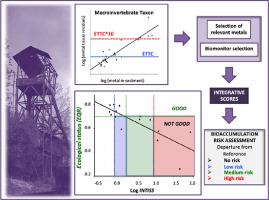Aquatic Toxicology ( IF 4.1 ) Pub Date : 2021-07-22 , DOI: 10.1016/j.aquatox.2021.105918 Pilar Rodriguez 1 , Iñigo Moreno-Ocio 1 , Maite Martínez-Madrid 2 , Noemi Costas 3 , Isabel Pardo 3 , Leire Méndez-Fernández 1

|
Development of sound criteria for metal and metalloid bioaccumulation risk assessment in river basins affected by mining activities is a necessary tool to protect the aquatic communities. The aim of this study is to propose integrative scores for tissue residues that are suitable for surveillance programs and readily interpreted in terms of risk assessment in mining impacted rivers. Tissue residues of 7 trace metals and 2 metalloids were measured in ten macroinvertebrate taxa from the Nalón River basin (Spain), affected by Hg, Cu and Au mining activities. Compared with reference sites, biomonitor taxa from Hg and Au mining districts showed the highest bioaccumulation. However, low or non-significant bioaccumulation was found in sites influenced by historical Cu mining. Multivariate analyses (ANOSIM) performed on individual taxa revealed significant differences in tissue residues between sites classified according to their ecological status. The bioaccumulation risk assessment was based on the average ratio of the actual metal tissue residues in each macroinvertebrate taxon to the corresponding Ecological Threshold tissue concentration (Tissue residue Ratio to Threshold, TRT). The suitability of the biomonitors was evaluated using linear regression models fitted to the relationships between TRT scores and site sediment pollution or ecological status scores. Biomonitor selection also considered differences in invertebrate functional traits, which can influence metal and metalloid bioavailability. Site bioaccumulation risk was assessed on an Integrated Tissue concentration score (INTISS), calculated over a selection of the most relevant chemicals (As, Cu and Hg) and 3 biomonitor taxa (Baetidae, Hydropsychidae, Microdrile oligochaetes) comprising a set of feeding styles. Based on INTISS, it was possible to predict community alteration scores, using linear regression models. A comparison of site bioaccumulation and ecological status assessments based on the departure from reference conditions showed that operational monitoring programs in basins impaired by mining can be optimized by combining both approaches.
中文翻译:

受地雷影响河流金属生物富集风险评估综合评分和生物监测仪选择的建议
制定受采矿活动影响的河流流域金属和类金属生物累积风险评估的健全标准是保护水生群落的必要工具。本研究的目的是提出适用于监测计划的组织残留物的综合评分,并易于根据受采矿影响的河流的风险评估进行解释。在纳隆河流域(西班牙)受汞、铜和金采矿活动影响的 10 个大型无脊椎动物类群中测量了 7 种痕量金属和 2 种类金属的组织残留物。与参考点相比,来自汞和金矿区的生物监测类群显示出最高的生物富集性。然而,在受历史铜矿开采影响的地点发现了低度或不显着的生物累积。对各个类群进行的多变量分析(ANOSIM)显示,根据生态状况分类的地点之间的组织残留物存在显着差异。生物累积风险评估基于每个大型无脊椎动物分类单元中实际金属组织残留量与相应生态阈值组织浓度的平均比率(组织残留比阈值,TRT)。使用适合 TRT 评分与场地沉积物污染或生态状况评分之间关系的线性回归模型来评估生物监测器的适用性。生物监测器的选择还考虑了无脊椎动物功能性状的差异,这会影响金属和类金属的生物利用度。现场生物累积风险通过综合组织浓度评分 (INTISS) 进行评估,该评分通过选择最相关的化学物质(As、Cu 和 Hg)和 3 个生物监测类群(Baetidae、Hydropsychidae、Microdrileoligochaetes)组成,包括一组摄食方式。 基于 INTISS,可以使用线性回归模型来预测社区改变分数。基于偏离参考条件的现场生物累积和生态状况评估的比较表明,可以通过结合这两种方法来优化受采矿损害的流域的运行监测计划。











































 京公网安备 11010802027423号
京公网安备 11010802027423号